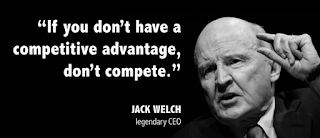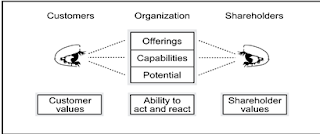The Role of Competitiveness in Your Business Strategy
 |
| [Image Credit: quotationof.com] |
Business strategies are formulated to determine the way in
which organizations can move from their current competitive position to a new
stronger one. This can only be achieved by improving an organization’s
competitiveness (Feurer and Chaharbaghi, 1994).
1. Defining Competitiveness
A universal and exact definition for competitiveness does
not exist. In determining a definition for competitiveness it is important to
question the reason for being of an organization and the key players who
determine its survival (Feurer and Chaharbaghi, 1992).
Many of the current definitions of competitiveness are essentially
centered on the capabilities and offerings of an organization with regard to
the competitors (Bowman, 1992; Stalk, 1992; Grant, 1991). In other words, the
key players are the organization, its customers and competitors. No account is
given to the shareholders who provide the necessary capital base and influence the
business objectives.
Furthermore, the current definitions also view
competitiveness as a static concept (i.e. how competitive an organization is at
a particular moment in time) and little consideration is given to its sustainability.
In summarizing the definition of competitiveness, Feurer and
Chaharbaghi (1992) contend that: Competitiveness is relative and not absolute.
It depends on shareholder and customer values, financial strength which determines
the ability to act and react within the competitive environment and the
potential of people and technology in implementing the necessary strategic
changes. Competitiveness can only be sustained if an appropriate balance is
maintained between these factors, which can be of a conflicting nature.
2.
Assumptions underlying Organizational Competitiveness
Feurer and
Chaharbaghi (1994) proposed the following assumptions as underpinning
competitiveness:
- For an organization to exist there has to be a demand for its offerings.
- The ultimate goal of an organization is to make a profit in order to satisfy its shareholders and achieve continuous profit growth while fulfilling the interest of other stakeholders such as employees.
- Competition arises when several organizations strive to make a profit by satisfying the same demand.
3.
Components of Organizational Competitiveness
Organizational competitiveness is made up of three main
components: customer values, ability to act and react, and shareholder value.
You Might Also Like:
- Food for Thought 1.0.0.
- Fashion in Ghana
- Knowledge Base of Businesses on Facilities Management
- Rural Banking and Evolution of Banking
3.1 Customer
Values
An organization is competitive in the eyes of its customers
if it is able to deliver a better value when compared with its competitors.
Superior value results through lower prices for equivalent benefits or
differentiated benefits that justify a higher price (Porter, 1985).
Customer value
can therefore be considered as the benefit perceived by the customer in
relation to the demanded price. It can be expressed as:
Customer Value = Benefit/Price
3.2 Shareholder
Values
Secondly, an organization is competitive in the eyes of its shareholder
if it is able to provide a satisfactory return on investment in the short,
medium and long terms. Different shareholders have different preferences
concerning rate of return, characteristics of return (e.g. capital gain or dividend
yield) and the risks attached.
Furthermore, the shareholders may have other interests,
which are not directly related to the financial performance (e.g. access to key
technologies and expertise that may be used for other business interests). Shareholder
values will therefore influence the decisions concerning the dividend policy,
growth strategy and capital structure which will in turn determine the
long-term wellbeing and profit potential of the organization.
3.3 Ability to Act and
React
This is the third component of competitiveness and can be defined
as the ability to retain the competitive position of an organization by
satisfying the expectations of customers and shareholders while constantly
eliminating the threats and exploiting the opportunities which arise in the
competitive environment. Competitiveness can only be maintained through
continuous improvement of the offerings and capabilities of an organization.
This requires a sound financial strength to fund the necessary strategic changes
such as the introduction of new technologies.
Financial strength
incorporates two aspects:
(1) short-term financial strength which determines the
ability of an organization to act and react swiftly (this is related to the
availability of short term capital);
(2) long-term financial strength which determines the ability
to raise capital for major investments such as the introduction of a new
product range and production facility.The ability to act and react does not
only depend on the financial strength but also on people and access to the key technologies.
In conclusion, competitiveness is
the cornerstone of an effective business strategy.
Is your organization being competitive enough?
You Might Also Like:


.webp)







No comments: